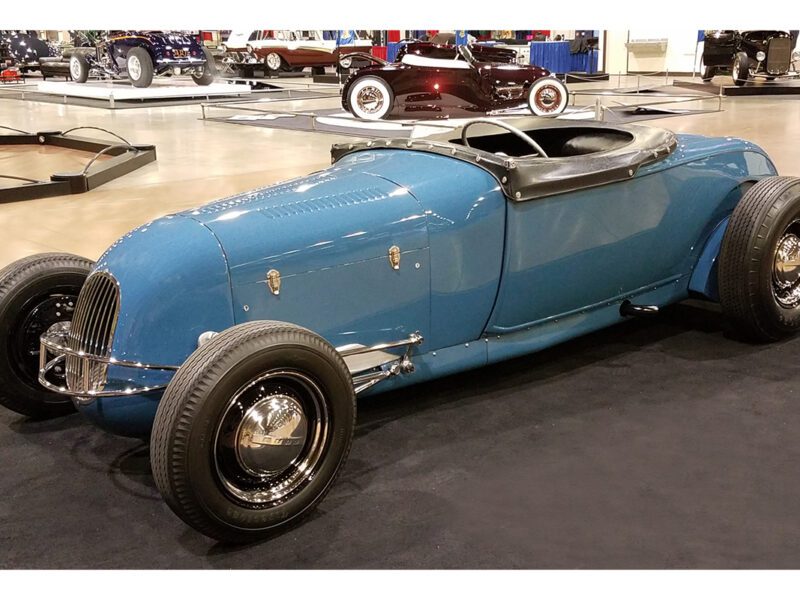Future Shock – Tex Smith’s XR-6 AMBR Winner
LeRoi “Tex” Smith was one of hot rodding’s most influential and iconoclastic figures. He joined NHRA’s Safety Safari and the Hot Rod magaine staff in 1953, helped launch Rod Action and Street Rodder, and co-created the Street Rod Nationals with Tom Medley and Rod & Custom magazine.
Later, he published countless books on home-grown hot rodding, and launched Hot Rod Mechanix, a monthly dedicated to low-cost car crafting. That ethic was exemplified by his “dollar-a-pound” 1930 Ford roadster project, which showed readers how to put together a traditional highboy on the cheap.
A tall, imposing personality who once was a minor-leaguer in the St Louis Cardinal organization, Tex was a terrific writer and storyteller. In other words, his fingerprints are on nearly every aspect of the street rod industry.
Which brings us to our feature car, the XR-6. If the later years of Smith’s career were devoted to promoting hot rodding’s do-it-yourself roots, the XR-6 is the Yin to that Yang – a futuristic concept designer car built by a team of the era’s most star-studded craftsmen.

Smith suggested taking a classic body style, modernizing its styling, and adding contemporary power and suspension, thus creating a modern looking and handling vehicle. HRM editor Bob Greene agreed and charged Smith with building a project car that followed that blueprint.
Smith first approached artist Steve Swaja, a student at Art Center College of Design, to pen the concept, one that would meld a ’27 T body with a race-car-like nose. Coincidentally, model kit maker AMT was looking offer a 2-in-1 model kit that featured a stock car and a hot rod based on the same body. AMT decided to piggyback Tex’s effort. Moreover, AMT wanted an even more futuristic design than that of Swaja’s. To sweeten the deal, AMT offered to fund the entire project – for publicity in Hot Rod, of course.
Tex already had a unique power plant in mind, a limited-production aluminum Dodge Slant 6 fed with Weber carbs and mated to Torqueflite trans. Smith welded up the chassis from 2×4-inch mild steel frame in a simple ladder design. He employed a VW torsion-bar front suspension and a Dodge reared supported by coil-over shocks. Disc brakes from a British sports car were grafted onto the VW spindles.
 Since AMT had George Barris under contract, the famous customizer was assigned to complete the bodywork, finalizing the initial aluminum panels crafted by Jack Hagemann.
Since AMT had George Barris under contract, the famous customizer was assigned to complete the bodywork, finalizing the initial aluminum panels crafted by Jack Hagemann.
The fenders were sculptured from sheet stock and matched the Firestone tires and Cragar wheels. Legendary Gene Winfield hand-formed the aluminum hood, fenders, and side panels. Equally legendary Tony Nancy stitched up the white leather upholstery.
Tex’s only concern was Barris’ over reliance on lead filler. During construction, Barris cleverly camouflaged his use of lead under a daily coat of primer. The final result was a sleek but heavy body — so heavy it took seven people to lift it off the chassis! Forty coats of Kandy Tangerine paint added to the heft.
The XR-6 was scheduled to debut at the 1963 Oakland Roadster Show to vie for America’s Most Beautiful Roadster award. One hiccup: the car wasn’t finished. Smith informed show promoter Al Slonaker that the car wouldn’t make it in time. Slonaker was aghast, replying that the car had already been awarded the AMBR trophy! The XR-6’s reputation preceded it, as they say.
Smith and crew managed to get to the XR-6 to the altar on time, with finishing touches added as it was rolled onto the show floor. With its George Jetson vibe, Hot Rod mag bona fides, and team of celebrity artisans, it lived up to its advance billing. Later the car received a multi-page spread in HRM, including the cover – an image of the XR-6 on the tarmac next to fighter jet, a nod to Tex’s experience as a former Air Force jet jockey.
As with most legendary hot rods, the XR-6 bounced around to various owners. In 2017 it was presented at the Pebble Beach in a category titled “American Dream Cars of the 1960s.” In publicity materials for Pebble, automotive historian and judge Ken Gross wrote:
“The XR-6 Roadster looks like a full-scale car from a vintage amusement park kiddie ride…born in the misty haze of imagination, transformed into real metal and rubber and Plexiglas, belching sooty exhaust.” Hard to argue.
Today, the XR-6 is safely ensconced in the Petersen Automotive Museum in Los Angeles, a logical home for one of hot rodding’s most groundbreaking creations.





